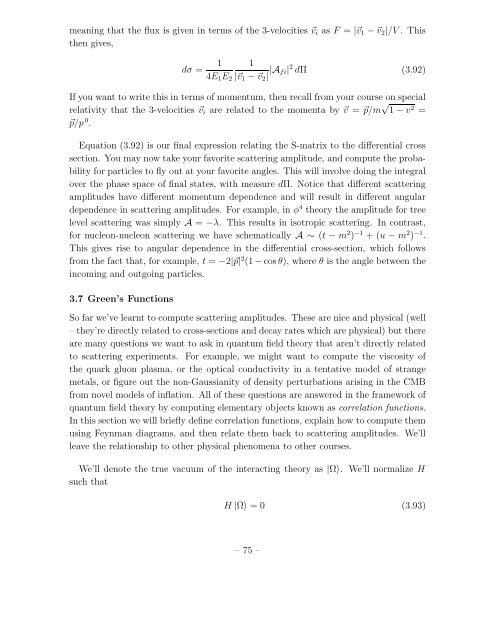Quantum Field Theory
Quantum Field Theory
Quantum Field Theory
You also want an ePaper? Increase the reach of your titles
YUMPU automatically turns print PDFs into web optimized ePapers that Google loves.
meaning that the flux is given in terms of the 3-velocities ⃗v i as F = |⃗v 1 − ⃗v 2 |/V . Thisthen gives,dσ = 14E 1 E 21|⃗v 1 − ⃗v 2 | |A fi| 2 dΠ (3.92)If you want to write this in terms of momentum, then recall from your course on specialrelativity that the 3-velocities ⃗v i are related to the momenta by ⃗v = ⃗p/m √ 1 − v 2 =⃗p/p 0 .Equation (3.92) is our final expression relating the S-matrix to the differential crosssection. You may now take your favorite scattering amplitude, and compute the probabilityfor particles to fly out at your favorite angles. This will involve doing the integralover the phase space of final states, with measure dΠ. Notice that different scatteringamplitudes have different momentum dependence and will result in different angulardependence in scattering amplitudes. For example, in φ 4 theory the amplitude for treelevel scattering was simply A = −λ. This results in isotropic scattering. In contrast,for nucleon-nucleon scattering we have schematically A ∼ (t − m 2 ) −1 + (u − m 2 ) −1 .This gives rise to angular dependence in the differential cross-section, which followsfrom the fact that, for example, t = −2|⃗p| 2 (1 −cos θ), where θ is the angle between theincoming and outgoing particles.3.7 Green’s FunctionsSo far we’ve learnt to compute scattering amplitudes. These are nice and physical (well– they’re directly related to cross-sections and decay rates which are physical) but thereare many questions we want to ask in quantum field theory that aren’t directly relatedto scattering experiments. For example, we might want to compute the viscosity ofthe quark gluon plasma, or the optical conductivity in a tentative model of strangemetals, or figure out the non-Gaussianity of density perturbations arising in the CMBfrom novel models of inflation. All of these questions are answered in the framework ofquantum field theory by computing elementary objects known as correlation functions.In this section we will briefly define correlation functions, explain how to compute themusing Feynman diagrams, and then relate them back to scattering amplitudes. We’llleave the relationship to other physical phenomena to other courses.We’ll denote the true vacuum of the interacting theory as |Ω〉. We’ll normalize Hsuch thatH |Ω〉 = 0 (3.93)– 75 –
















